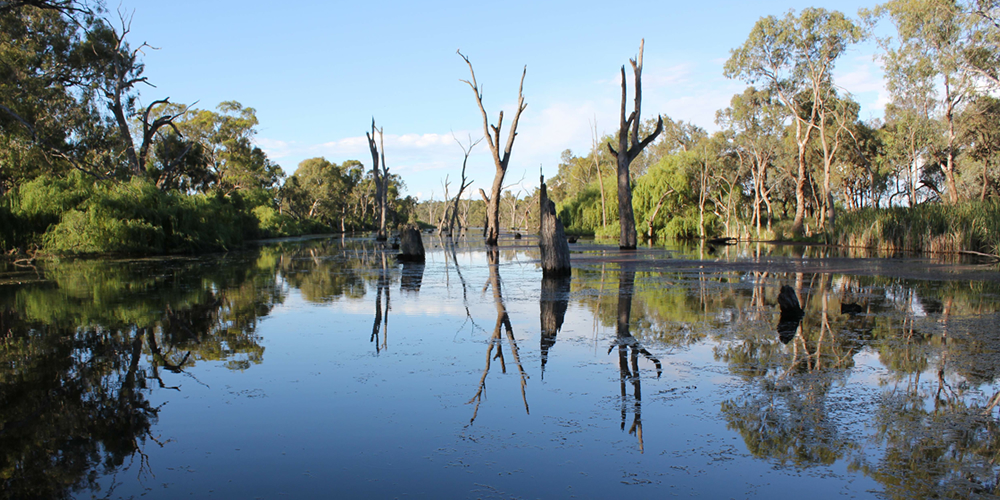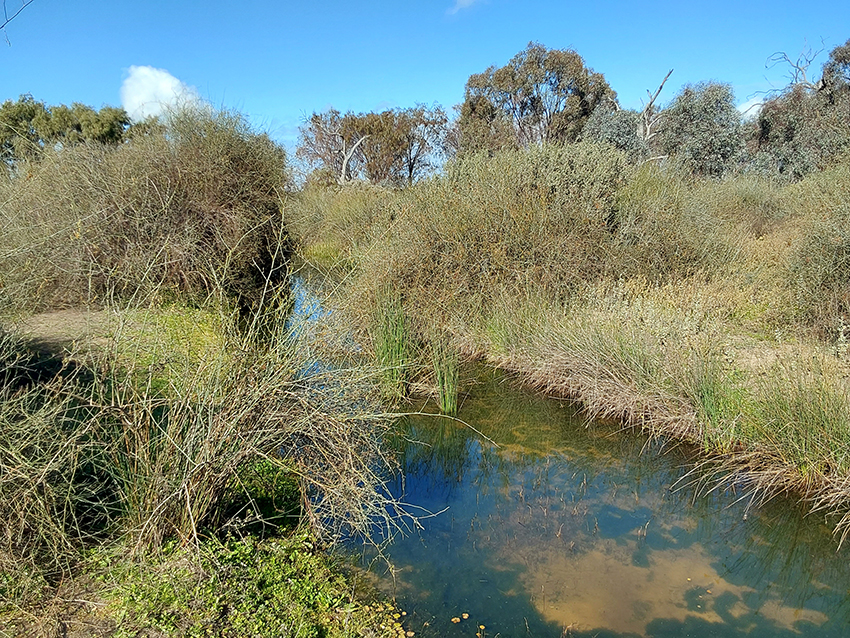Innovative Farming Program
Farm Business Planning
The Irrigation Farm Business Plan, a key tool of the Plan2Farm program, provides the opportunity for you to assess where your business is situated now and where you want it to be in the future.
Loddon Murray Wetlands
Kerang Wetlands protection
The Kerang Wetlands are a unique system of more than 100 wetlands with 23 lakes and swamps recognised under the Ramsar Convention for providing habitat to significant waterbird populations.
Protecting the wetlands includes targeting threatening pests including Weeds of National Significance, rabbits and foxes which all undermine the ecological character of Ramsar sites.
Loddon River
The Loddon River flows north from the Great Dividing Range in central Victoria to the Murray River, with three main storages - Cairn Curran, Tullaroop and Laanecoorie reservoirs.
Its lower reaches are critical vegetation corridors in a landscape with only 13% of original vegetation remaining.
The Plan
The Native Fish Recovery Plan has a clear aim; to restore native fish populations and waterway health in the Central Murray system in northern Victoria.
Loddon Stressed River
Priority asset to be protected:
The Loddon River downstream of Cairn Curran Reservoir is listed as a flow-stressed river in the 2002 Victorian River Health Strategy.
Overview:
Gunbower Forest Floodplain
Gunbower Forest
Gunbower Forest spans 20,000 hectares along the Murray River floodplain near Cohuna, downstream from Echuca.
Gunbower Creek

Gunbower Creek
As the southern border to Gunbower Forest, Gunbower Creek is also a priority for healthy waterway flows.
Gunbower Creek is one of the region's most important waterways, with high environmental, cultural and economic values.
Tullaroop Catchment
The Tullaroop catchment is within the upper Loddon River Basin and is the area inclusive and upstream of Tullaroop Reservoir (including Tullaroop, Birch’s and Creswick creeks)
Round Lake
Round Lake
Round Lake remained permanently inundated and continued to receive a series of top-ups to maintain suitable conditions for Murray hardyhead. The wetland also provide feeding conditions for a variety of waterbirds although compared to recent years the average number of birds observed during the spring and summer period dropped from 1,600 to 750, with the number of observed species richness also decreasing from 15 to 8 species.
Lake Elizabeth
Lake Elizabeth
Lake Elizabeth received a series of top-ups aimed at establishing suitable conditions for future Murray hardyhead translocation. These deliveries have bolstered the abundance of saline aquatic plant biomass in the wetland, with a 65% increase in coverage since environmental water was first delivered in 2014.
Richardson's Lagoon
Richardson's Lagoon
During spring, Richardson's Lagoon was filled from near empty and overtopped to inundate a small section of the adjacent floodplain.
The event created a range of habitat types for waterbird resting, nesting and feeding and supported floodplain plants communities that have not received water since environmental water was delivered in spring 2012. The event saw up to 19 different waterbird species utilising the wetland, with particularly high abundance of grey teal, Australian pelican and Pacific black duck.
Lake Murphy
Lake Murphy
Lake Murphy maintained water from the spring 2014 Watering event until January 2016. The wetland continued to support a diverse range of waterbirds throughout spring and early summer 2015 including at least 25 species and more than 1,000 individuals.
Species of particular interest include Australian shoveler, hardhead, intermediate egret, royal spoonbill, sharp-tailed sandpiper and whiskered tern. In addition a brolga pair was observed at the wetland in February 2015 with a juvenile spotted in October 2015.
Johnson Swamp
Johnson Swamp
Johnson Swamp received a partial fill in autumn 2015 to prime conditions for a spring top-up that occurred between late September and mid October 2015.
The top-up was delivered at a steady rate with the aim of promoting an increase in aquatic plant biomass, providing an abundance of food for waterbirds, frogs and turtles. The event was also carefully managed to ensure a brolga nest discovered in September 2015, was not drowned or damaged.
Wirra-Lo Wetland Complex
Wirra-Lo Wetland Complex
Wirra-Lo Wetland Complex was partially filled in autumn 2015 to prime conditions for a series of top-ups that occurred between October and December 2015 and in April and May 2016.
The Watering event stimulated the growth of a diverse range of aquatic and amphibious plant species as well as an abundance of waterbirds including threatened Ballion's crake, Latham's snipe and royal spoonbill. Migratory sharp-tailed sandpiper and marsh sandpiper were also recorded at the wetland complex.
Bringing Back the Bittern
It’s a bird that is a key part of Australia’s culture and mythology, but most people don’t even know what it looks like.
Tullaroop Catchment Restoration Project
The Tullaroop Catchment Restoration Project targets the Tullaroop catchment area upstream of Tullaroop Reservoir, a declared potable water supply catchment on Dja Dja Wurrung.
Loddon Murray Surface Water Management Strategy

The Loddon Murry Irrigation Region Surface Water Management Strategy addresses the ongoing need and works for drainage within the Loddon and Murray Irrigation Areas.
